| Pages:
1
2 |
woelen
Super Administrator
        
Posts: 8012
Registered: 20-8-2005
Location: Netherlands
Member Is Offline
Mood: interested
|
|
More fun with thiourea
As you may have read, I did some experimenting with oxidation of thiourea (see http://www.sciencemadness.org/talk/viewthread.php?tid=22583), but while doing so, I found more interesting properties, which I want to share.
Reduction of copper(II) to copper(I)
Thiourea reacts with copper(II) ions to give a perfectly colorless solution. Not the faintest blue or greens. Prepare a solution of thiourea in water
and add a solution of copper sulfate to this. Assure that thioutrea is present in excess amounts. The liquid at once becomes colorless. The only
explanation I have for this is that thiourea reduces copper(II) to copper(I) and then forms a complex with copper(I) which is colorless.
Strange reaction with nitrite in acidic solution
Dissolve some thiourea in water and in a separate test tube dissolve some sodium nitrite or potassium nitrite in water. Mix the two liquids. Nothing
seems to happen.
Next, add a few drops of dilute sulphuric acid. At once, the liquid turns dark brown/red and bubbles of gas are produced. The gas contains some NOx,
but this can of course be explained, due to decomposition of nitrite in acidic solution to HNO2, N2O3, NO and NO2. Most of the gas, however, is
colorless and each time when the liquid is shaken, more gas seems to be formed, while no gas is produced when it just stands without shaking.
The brown color slowly fades again. After ten minutes or so, the color is yellow/brown. When this yellow/brown liquid is allowed contact with nitrous
vapors (NOx), then at the surface a dark red/brown color can be observed again.
If a reverse experiment is done, then the same behavior is obtained. E.g. if solid NaNO2 is added to a solution of thiourea in dilute sulphuric acid,
then an intense deep red/brown liquid is obtained and a lot of colorless gas with a little bit of NOx.
Complex formation with iron(III)
When a few drops of a solution of FeCl3 in water is added to an excess amount of a solution of thiourea, then the liquid turns red/brown (very much
like in the previous experiment, but the color is less intense). After standing for an hour, the liquid becomes colorless! This is quite remarkable
for iron(III) in non-acidic solution. Most likely the iron(III) is reduced to iron(II) and this iron(II) forms a colorless complex with thiourea. The
glass was covered with a very thin layer of white solid.
All these three observation are quite remarkable, especially the reaction with nitrite in acidic solution. With the iron and copper I have some clue
on what might happen, but with the nitrite I have not the faintest idea what the brown material may be. Nitrite is said to react with thiourea to
thiocyanic acid, which is colorless. Thiocyanic acid in turn reacts with nitrite to a deep red/brown compound. It is not clear to me what this is.
Indeed, when nitrite and thiocyanate are mixed and acidified, then the same reaction occurs (it is documented on my website).
[Edited on 5-1-13 by woelen]
|
|
|
Adas
National Hazard
   
Posts: 711
Registered: 21-9-2011
Location: Slovakia
Member Is Offline
Mood: Sensitive to shock and friction
|
|
N2O3 (or the mix of NO and NO2) is blue in solution without thiourea and makes colorless bubbles, which turn brown upon contact with air (NO2). The
bubbles evolving when you shake it probably have something to do with N2O3 solubility (like shaking a Coca-Cola bottle).
Rest In Pieces!
|
|
|
watson.fawkes
International Hazard
    
Posts: 2793
Registered: 16-8-2008
Member Is Offline
Mood: No Mood
|
|
Quote: Originally posted by woelen  | | Thiourea reacts with copper(II) ions to give a perfectly colorless solution. Not the faintest blue or greens. Prepare a solution of thiourea in water
and add a solution of copper sulfate to this. Assure that thioutrea is present in excess amounts. The liquid at once becomes colorless. The only
explanation I have for this is that thiourea reduces copper(II) to copper(I) and then forms a complex with copper(I) which is colorless.
|
This might have some very practical value in titrating copper chloride etchant, which has a mixture of
copper +1 and +2 oxidation states when spent. If it's to work, the thiourea would need to displace chlorine ions in the copper complex, and to do so
fairly rapidly. But the benefit of a stark color change would make for a sharper and easier measurement.
What was the counter-ion in your copper solution?
|
|
|
woelen
Super Administrator
        
Posts: 8012
Registered: 20-8-2005
Location: Netherlands
Member Is Offline
Mood: interested
|
|
The counter-ion was sulfate, but I also tried with sulphamate, another rather inert anion. No different results. I did not try with CuCl2 though.
|
|
|
kmno4
International Hazard
    
Posts: 1496
Registered: 1-6-2005
Location: Silly, stupid country
Member Is Offline
Mood: No Mood
|
|
Thiourea....complexes.....Cu.....reduction.....
- it is known for a long time.
You may also "discover" reaction of thiourea+Cu+HCl(aq): Cu dissolves, giving complexed Cu(I) and H2.
In attachment - 3D structure of one of the complexes from mixture CuSO4aq and thiourea. Use any program reading CIF files like Mercury (free), etc
Attachment: ca0005.cif (18kB)
This file has been downloaded 915 times
Слава Україні !
Героям слава !
|
|
|
woelen
Super Administrator
        
Posts: 8012
Registered: 20-8-2005
Location: Netherlands
Member Is Offline
Mood: interested
|
|
I did not know of reduction by copper of a thiourea/HCl solution. This indeed is a most remarkable reaction.
I tried the reaction as follows:
- Prepare a fairly concentrated solution of thiourea in 10% HCl.
- Add a small amount of finely powdered copper metal.
When this is done, no visible reaction occurs. Next I carefully heated the liquid and when this is done, then a slow reaction starts. Small bubbles
are produced. I tried igniting the gas, but I did not get any flames or pop/whoosh sounds. The amount of gas probably was too small. But there
definitely is a reaction. After 15 minutes or so, a flocculent white solid is formed, which slowly mixes with the powdered copper and makes a
dirty-looking red/brown mix.
I added some water to the mix and when this is done, the dirty-looking flocculent solid slowly dissolves and a clear liquid is obtained, with some
copper powder on the bottom.
Next, I decanted the clear liquid in a separate test tube and added a few drops of concentrated bleach (more than 12% active chlorine). This leads to
formation of a white precipitate. On shaking, this white precipitate does not dissolve again. Next, I added an excess amount of 10% H2O2. When this is
done, then slowly the precipitate dissolves and the liquid becomes clear and very pale blue.
So, there definitely is a reaction between copper and a thiourea/dilute HCl solution. More experimenting is needed to get more insight in this
reaction. I just did a quick experiment, before it was time for me to go asleep.
-------------------------------------------------------------------------
EDIT: I did some research on this reaction on internet and found that oxidation of copper(0) to copper(I) is favored by the presence of thiourea:
Cu --> Cu(+) + e
Normally, this reaction does not occur, but in the presence of thiourea a complex is formed and the copper lets itself be oxidized much more easily:
Cu + 3 Tu --> CuTu3(+) + e (here Tu stands for thiourea)
The oxidizer is hydrogen from the acid: 2H(+) + e --> H2
So, the total reaction is 2 Cu + 6 Tu + 2 H(+) --> 2 CuTu3(+) + H2
Have a look at this link: http://infohost.nmt.edu/~jaltig/CuCmpds.pdf
Based on this document and other info from the internet one can fairly safely conclude that the equations above indeed are a good description of the
reaction between copper and acidified thiourea solution.
[Edited on 4-1-13 by woelen]
|
|
|
Nicodem
Super Moderator
      
Posts: 4230
Registered: 28-12-2004
Member Is Offline
Mood: No Mood
|
|
For those who are to lazy to install Mercury, here is the structure from the CIF file posted by kmno4. The compound is hexa(thiourea)dicopper(I)
sulphate monohydrate. It has a Cu(I) each bonded with four thiourea ligands (two of them as bridging ligands), while the sulfate anion and hydration
water apparently do not participate in bonding.
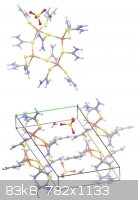
…there is a human touch of the cultist “believer” in every theorist that he must struggle against as being
unworthy of the scientist. Some of the greatest men of science have publicly repudiated a theory which earlier they hotly defended. In this lies their
scientific temper, not in the scientific defense of the theory. - Weston La Barre (Ghost Dance, 1972)
Read the The ScienceMadness Guidelines!
|
|
|
Nicodem
Super Moderator
      
Posts: 4230
Registered: 28-12-2004
Member Is Offline
Mood: No Mood
|
|
Attached is the article from which the above XRD derived structure originates:
X-ray diffraction study of copper(I) thiourea complexes formed in sulfate-containing acid solutions
Acta Cryst. 2000, B56, 993-997. DOI: 10.1107/S0108768100008028
O. E. Piro, R. V. Piatti, A. Bolzán, R. Salvarezza and A. Arvia
The synthesis of the various Cu(I) thiourea complexes appears simple and the products can be crystallized out. The type of product that forms depends
on the CuSO4 vs. thiourea ratio. Looks like a nice goal for amateur synthesis.
| Quote: | | Copper(I) thiourea complexes were prepared by mixing in a50 cm3 glass reactor, with stirring, different amounts of x mM(0.2 x 2) of copper sulfate and
y mM (0.6 y 20) ofthiourea aqueous 0.5 M sulfuric acid at room temperature. |
Attachment: 0993-0997.pdf (86kB)
This file has been downloaded 1624 times
…there is a human touch of the cultist “believer” in every theorist that he must struggle against as being
unworthy of the scientist. Some of the greatest men of science have publicly repudiated a theory which earlier they hotly defended. In this lies their
scientific temper, not in the scientific defense of the theory. - Weston La Barre (Ghost Dance, 1972)
Read the The ScienceMadness Guidelines!
|
|
|
kmno4
International Hazard
    
Posts: 1496
Registered: 1-6-2005
Location: Silly, stupid country
Member Is Offline
Mood: No Mood
|
|
There is much better paper for amateur purposes, with given direct and simple procedures for:
Hexakis(thiourea)dicopper(I) Sulfate Hydrate ([Cu2(tu)6]SO4•H2O), Pentakis(thiourea)dicopper(I) Sulfate Trihydrate
([Cu2(tu)5]SO4•3H2O), Heptakis(thiourea)tetracopper(I) Disulfate Hydrate ([Cu4(tu)7](SO4)2•H2O), and two nitrates.
DOI of mentioned paper: 10.1021/ic970910q
Of course, there is always another way, by mixing x spatulas of A, y spatulas of B, z spatulas of C... 
[Edited on 11-1-2013 by kmno4]
Слава Україні !
Героям слава !
|
|
|
Hexavalent
International Hazard
    
Posts: 1564
Registered: 29-12-2011
Location: Wales, UK
Member Is Offline
Mood: Pericyclic
|
|
OTC Thiourea
I was in the supermarket earlier today and was browsing the shelves of cleaning products. I came across a solution which is sold to restore and remove
tarnish from silver, and it seems to be a concentrated solution of thiourea in water!
It also seems to contain a surfactant, which causes a little foaming upon shaking, but shouldn't be too much of an issue for most reactions, I
suspect.
"Success is going from failure to failure without loss of enthusiasm." Winston Churchill
|
|
|
mnick12
Hazard to Others
  
Posts: 404
Registered: 30-12-2009
Location: In the lab w/ Dr. Evil
Member Is Offline
Mood: devious
|
|
Yes, I believe the product you are referring to is called Tarn-X. That surfactant could be a pain to remove, you are better off buying the pure
thiourea it is dirt cheap depending which grade you buy.
On another note, to my knowledge some of the substituted thioureas are used as brighteners in the copper plating industry and encourage the deposition
of crystalline copper rather than the sponge like material. I wonder if similar complexes are formed with substitued thioureas. Any thoughts?
|
|
|
Hexavalent
International Hazard
    
Posts: 1564
Registered: 29-12-2011
Location: Wales, UK
Member Is Offline
Mood: Pericyclic
|
|
No, not here in the UK. We've a product called "Goddard's Silver Dip", which is what I bought;

"Success is going from failure to failure without loss of enthusiasm." Winston Churchill
|
|
|
woelen
Super Administrator
        
Posts: 8012
Registered: 20-8-2005
Location: Netherlands
Member Is Offline
Mood: interested
|
|
I would not like to work with a product like that. Thiourea is not expensive at all. Good purity material (e.g. 99% or so) can be purchased for a few
euros or dollars per 100 gram, technical grade thiourea is even cheaper. I purchased my thiourea from a raw chemical photography supplier.
http://www.artcraftchemicals.com/products/general-chemistry
|
|
|
woelen
Super Administrator
        
Posts: 8012
Registered: 20-8-2005
Location: Netherlands
Member Is Offline
Mood: interested
|
|
No crystals, just some kind of oil when making cuprous complex
I tried making copper thiourea complex, according to this page (click for PDF document):
Experimental description for making cuprous thiourea complexes
I tried making the sulfate. When I perform the first step, I get a yellowish oil, which easily can be separated from the water. This oil is turbid.
When I shake this oil with a solution of 2 grams of thiourea in 20 ml of water, then I do not get crystals. I keep having the same oil, but now it
becomes (nearly) transparent and has a pale yellow color. Apparently the shaking cleans the oil.
Instead of filtering and washing crystals, I again decanted the aqueous layer from the oil and I performed the third step. I added 15 ml of a warm 5%
solution of thiourea to which two drops (appr. 0.05 ml per drop) of dilute (2 M) sulphuric acid was added. The oil dissolves in this solution (it
takes quite some time before all of it has dissolved) and I obtained a perfectly clear very pale yellow solution. On cooling down, this liquid becomes
turbid again and many small droplets of oil settle at the bottom and again I have oil at the bottom and no crystals. I allowed the liquid to cool down
well below 15 C and still get no crystals at this temperature.
What am I doing wrong? In previous experiments I also have seen this oil before, but I never obtained nice crystals. Apparently the complex has a very
low melting point.
|
|
|
barley81
Hazard to Others
  
Posts: 481
Registered: 9-5-2011
Member Is Offline
Mood: No Mood
|
|
Maybe it might crystallize if you cool the oil and "shaking solution" with ice before shaking. Just an idea, though..
|
|
|
woelen
Super Administrator
        
Posts: 8012
Registered: 20-8-2005
Location: Netherlands
Member Is Offline
Mood: interested
|
|
I have cooled the oil to nearly freezing (it is freezing cold where I live now and I left the material in the cold for more than a day), but still the
material is in the form of an oil. In fact, it is quite remarkable stuff. The oil now is somewhat lighter, it is a clear, very pale yellow liquid,
which forms a nice layer under the aqueous layer.
I made some pictures of the entire process and I'll create a webpage about this. Pictures are always nice to have. Although I do not have a nice pure
crystalline solid as an end product, I think that the result of this experiment is interesting enough to devote a web page to it. Maybe someone else
knows more about the pale yellow oil? I think it is quite remarkable, to have an oily liquid, containing copper in oxidation state +1.
[Edited on 15-1-13 by woelen]
|
|
|
Nicodem
Super Moderator
      
Posts: 4230
Registered: 28-12-2004
Member Is Offline
Mood: No Mood
|
|
An oily product generally means the otherwise solid product is in a mixture. In your case, the oil is probably a mixture of two or more complexes. The
Acta crystalographica and Inorg. Chem. articles both indicate that the various Cu-tu complexes are in dynamic equilibrium. In
practice, this means inhibited crystallization. You should therefore try to make sure the complex is fully saturated with ligands by letting it stir
longer in a solution of thiourea at room temperature. Perhaps your washing in thiourea solution was not efficient enough, or was done at a temperature
too low to allow for a fast enough ligand exchange (it is a biphasic mixture, after all).
An acidic media (H2SO4) during the reaction, like used in the articles, should also help in attaining better purity, by preventing the water soluble
reaction product (formamidine disulphide sulfate, I assume) from decomposing into contaminants. It also keeps the sulfate anion concentration high and
thus facilitates the crystallization. In fact, in the articles the Cu-tu complexes crystallize directly (without first oiling out).
The experimental in Inorg. Chem. is much more detailed and comprehensive.
…there is a human touch of the cultist “believer” in every theorist that he must struggle against as being
unworthy of the scientist. Some of the greatest men of science have publicly repudiated a theory which earlier they hotly defended. In this lies their
scientific temper, not in the scientific defense of the theory. - Weston La Barre (Ghost Dance, 1972)
Read the The ScienceMadness Guidelines!
|
|
|
kmno4
International Hazard
    
Posts: 1496
Registered: 1-6-2005
Location: Silly, stupid country
Member Is Offline
Mood: No Mood
|
|
I decided to prepare some Cu(I)-tu complexes, according to procedures given here and here.
Unfortunately I was not able to obtain ANY crystalline sample of ANY complex.
At best I get some low-melting powder, becoming sticky oil above ~40 C.
According to "Cu<sub>2</sub>O methode" from the second paper:
...to cool slowly.Large crystals formed, which were collected and washed with ice-cold water.Yield
5.1 g (86.4%).
I should have got "large crystals", but I get transparent colourless solution with NO precipitate or crystals. I did this experiment twice with the
same results: clear water-like liquid.
It is amazing, I do not know what is reason of it all. I even recrystallized my thiouera, but its melting point changed merely from 175-178 C to
176-178 C.
It would be interesting if someone else could repeat this procedure and report results here.
(experimental in attachment)
Attachment: prep.TIF (56kB)
This file has been downloaded 952 times
Слава Україні !
Героям слава !
|
|
|
kmno4
International Hazard
    
Posts: 1496
Registered: 1-6-2005
Location: Silly, stupid country
Member Is Offline
Mood: No Mood
|
|
.... also tried "sulfite reduction method" from mentioned paper.
Expected: A yellow oil and some white crystalline solid separated. The mixture was heated until the oil and solid dissolved, and filtered to
remove the remaining cloudiness.
Result: not soluble, yellowish oil. Prolonged heating and stirring caused only more yellowish colour (possibly sulfur).
I put is aside in a cold place, after 24h there was still oily layer on bottom, without any crystals.
After 3 days, surprise: oil turn to almost white, hard mass.
During heating again, white mass did not turn back to oil.
After cooling, a lot of needle-like (as paper says) small crystals appeard in remaing solution.
Crystals were separated and this hot extraction was repeated severel times.
Combined batches were recrystallized from tu-water solution (see paper). Almost white, small, glittering, soft, needle-like crystals were obtained.
According to paper, this is complex with formula [Cu2(tu)6]SO4•H2O.
At last small success 
Photo of raw material (left) and after recrystallisation step in attachment.
Attachment: pic.pdf (939kB)
This file has been downloaded 700 times
[Edited on 23-1-2013 by kmno4]
Слава Україні !
Героям слава !
|
|
|
woelen
Super Administrator
        
Posts: 8012
Registered: 20-8-2005
Location: Netherlands
Member Is Offline
Mood: interested
|
|
Nice to see your success with the copper-thiourea complex, but I get the feeling that it is a little bit of a lucky shot. Can it be reproduced? Next
weekend I hope to find some time for this and I'll try to reproduce your experiment.
Anyway, this is a type of experiment which very easily fails and the descriptions from many authors apparently does not mention the formation of oil
and the problems with the crystallization of the material.
|
|
|
chemrox
International Hazard
    
Posts: 2961
Registered: 18-1-2007
Location: UTM
Member Is Offline
Mood: LaGrangian
|
|
Here's a simple URL for Mercury:
http://tinyurl.com/http-Hg-dl
"When you let the dumbasses vote you end up with populism followed by autocracy and getting back is a bitch." Plato (sort of)
|
|
|
k2976
Harmless

Posts: 19
Registered: 16-12-2010
Member Is Offline
Mood: No Mood
|
|
Quote: Originally posted by woelen  | Strange reaction with nitrite in acidic solution
Dissolve some thiourea in water and in a separate test tube dissolve some sodium nitrite or potassium nitrite in water. Mix the two liquids. Nothing
seems to happen.
Next, add a few drops of dilute sulphuric acid. At once, the liquid turns dark brown/red and bubbles of gas are produced. The gas contains some NOx,
but this can of course be explained, due to decomposition of nitrite in acidic solution to HNO2, N2O3, NO and NO2. Most of the gas, however, is
colorless and each time when the liquid is shaken, more gas seems to be formed, while no gas is produced when it just stands without shaking.
The brown color slowly fades again. After ten minutes or so, the color is yellow/brown. When this yellow/brown liquid is allowed contact with nitrous
vapors (NOx), then at the surface a dark red/brown color can be observed again.
If a reverse experiment is done, then the same behavior is obtained. E.g. if solid NaNO2 is added to a solution of thiourea in dilute sulphuric acid,
then an intense deep red/brown liquid is obtained and a lot of colorless gas with a little bit of NOx. |
Wouldn't this just form a diazonium compound?
|
|
|
woelen
Super Administrator
        
Posts: 8012
Registered: 20-8-2005
Location: Netherlands
Member Is Offline
Mood: interested
|
|
I still had the oily liquid standing on my workbench, covered by a piece of plastic to avoid getting dust in the material and to my surprise, the
material has solidified and has formed white somewhat feather-like crystals! I now have the material drying at a warm place. I am really surprised
that after such a long time the material changed to a crystalline material.
|
|
|
Mailinmypocket
International Hazard
    
Posts: 1351
Registered: 12-5-2011
Member Is Offline
Mood: No Mood
|
|
Quote: Originally posted by woelen  | I tried making copper thiourea complex, according to this page (click for PDF document):
Experimental description for making cuprous thiourea complexes
I tried making the sulfate. When I perform the first step, I get a yellowish oil, which easily can be separated from the water. This oil is turbid.
When I shake this oil with a solution of 2 grams of thiourea in 20 ml of water, then I do not get crystals. I keep having the same oil, but now it
becomes (nearly) transparent and has a pale yellow color. Apparently the shaking cleans the oil.
Instead of filtering and washing crystals, I again decanted the aqueous layer from the oil and I performed the third step. I added 15 ml of a warm 5%
solution of thiourea to which two drops (appr. 0.05 ml per drop) of dilute (2 M) sulphuric acid was added. The oil dissolves in this solution (it
takes quite some time before all of it has dissolved) and I obtained a perfectly clear very pale yellow solution. On cooling down, this liquid becomes
turbid again and many small droplets of oil settle at the bottom and again I have oil at the bottom and no crystals. I allowed the liquid to cool down
well below 15 C and still get no crystals at this temperature.
What am I doing wrong? In previous experiments I also have seen this oil before, but I never obtained nice crystals. Apparently the complex has a very
low melting point.
|
I tried this experiment today- with the same results as you. I followed the instructions EXACTLY as written in the article you referenced. I also got
no crystals after shaking with the 20ml of thiourea solution before the recrystallization step. Very odd... I suppose I should let it sit for a while
and see what happens, but I find it odd that we got different results than the original authors of that prep.
Reagents before mixing
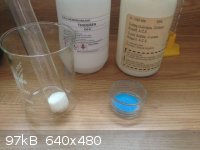
After dissolution
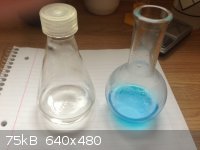
After slowly adding CuSO4 to the thiourea
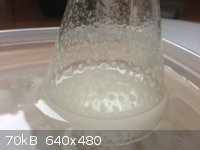
After decanting mother solution from oil adhering to flask
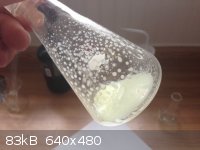
After shaking with thiourea solution... No crystallization.
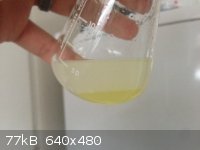
[Edited on 13-3-2013 by Mailinmypocket]
|
|
|
woelen
Super Administrator
        
Posts: 8012
Registered: 20-8-2005
Location: Netherlands
Member Is Offline
Mood: interested
|
|
I still did not make a web page about this subject, because an important criterion for me to add webpages to my website is that the results should be
reproducible by other people, provided they have the chemicals and apparatus used in the experiment. This experiment does not satisfy that criterion.
Apparently there is some unspecified good luck for some people, while others do not get the desired results.
I allowed the oil to stand for a few weeks and after that period I had crystals (feather-like), but I find the results of this experiment not
convincing at all.
|
|
|
| Pages:
1
2 |